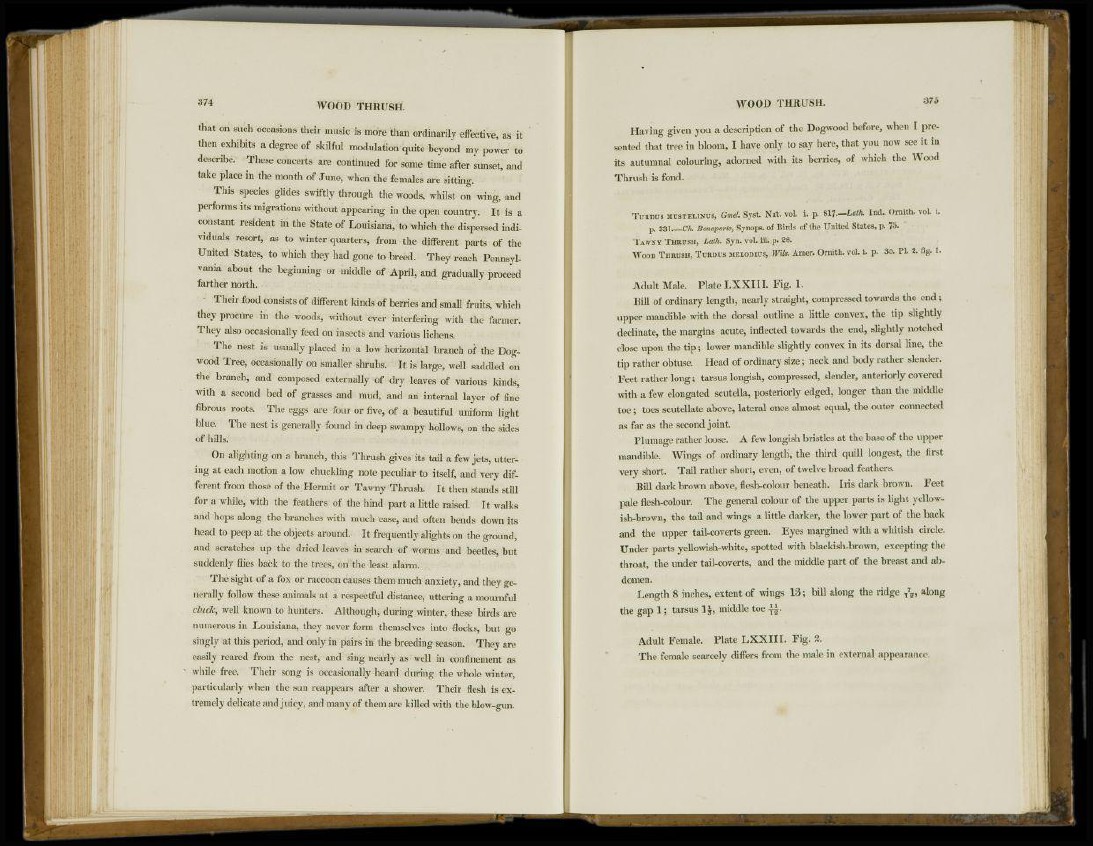
374 WOOD THRUSH.
that on such occasions their music is more than ordinarily effective, as it
then exhibits a degree of skilful modulation quite beyond my power to
describe. These concerts are continued for some time after sunset, and
take place in the month of June, when the females are sitting.
This species glides swiftly through the woods, whilst on wing, and
performs its migrations without appearing in the open country. It is a
constant resident in the State of Louisiana, to which the dispersed individuals
resort, as to winter quarters, from the different parts of the
United States, to which they had gone to breed. They reach Pennsylvania
about the beginning or middle of April, and gradually proceed
farther north.
• Their food consists of different kinds of berries and small fruits, which
they procure in the woods, without ever interfering with the farmer.
They also occasionally feed on insects and various lichens.
The nest is usually placed in a low horizontal branch of the Dogwood
Tree, occasionally on smaller shrubs. It is large, well saddled on
the branch, and composed externally of dry leaves of various kinds,
with a second bed of grasses and mud, and an internal layer of fine
fibrous roots. The eggs are four or five, of a beautiful uniform light
blue. The nest is generally found in deep swampy hollows, on the sides
of hills.
On alighting on a branch, this Thrush gives its tail a few jets, uttering
at each motion a low chuckling note peculiar to itself, and very different
from those of the Hermit or Tawny Thrush. It then stands still
for a while, with the feathers of the hind part a little raised. It walks
and hops along the branches with much ease, and often bends down its
head to peep at the objects around. It frequently alights on the ground,
and scratches up the dried leaves in search of worms and beetles, but
suddenly flies back to the trees, on the least alarm.
The sight of a fox or raccoon causes them much anxiety, and they generally
follow these animals at a respectful distance, uttering a mournful
chicle, well known to hunters. Although, during winter, these birds are
numerous in Louisiana, they never form themselves into flocks, but go
singly at this period, and only in pairs in the breeding season. They are
easily reared from the nest, and sing nearly as well in confinement as
- while free. Their song is occasionally heard during the whole winter,
particularly when the sun reappears after a shower. Their flesh is extremely
delicate and juicy, and many of them are killed with the blow-gun.
WOOD THRUSH. 375
Having given you a description of the Dogwood before, when I presented
that tree in bloom, I have only to say here, that you now see it in
its autumnal colouring, adorned with its berries, of which the Wood
Thrush is fond.
TURDUS MUSTELINUS, Gmel, Syst. Nat. vol. i. p. 817.—Lath. Ind. Ornith, vol. i.
p. 331.—Ch, Bonaparte, Synops. of Birds of the United States, p. ~o.
TAWNY THRUSH, Lath, Syn. vol. iii. p. 28.
WOOD THRUSH, TURDUS MELODIUS, Wils. Amer. Ornith. vol. i. p. 35. PI. 2. fig. I.
Adult Male. Plate LXXIII. Fig. 1.
Bill of ordinary length, nearly straight, compressed towards the end ;
upper mandible with the dorsal outline a little convex, the tip slightly
decimate, the margins acute, inflected towards the end, slightly notched
close upon the tip; lower mandible slightly convex in its dorsal line, the
tip rather obtuse. Head of ordinary size; neck and body rather slender.
Feet rather long; tarsus longish, compressed, slender, anteriorly covered
with a few elongated scutella, posteriorly edged, longer than the middle
toe; toes scutellate above, lateral ones almost equal, the outer connected
as far as the second joint.
Plumage rather loose. A few longish bristles at the base of the upper
mandible. Wings of ordinary length, the third quill longest, the first
very short. Tail rather short, even, of twelve broad feathers.
Bill dark brown above, flesh-colour beneath. Iris dark brown. Feet
pale flesh-colour. The general colour of the upper parts is light yellowish
brown, the tail and wings a little darker, the lower part of the back
and the upper tail-coverts green. Eyes margined with a whitish circle.
Under parts yellowish-white, spotted with blackish-brown, excepting the
throat, the under tail-coverts, and the middle part of the breast and abdomen.
Length 8 inches, extent of wings 13; bill along the ridge fa along
the gap 1; tarsus 1 \, middle toe
Adult Female. Plate LXXIII. Fig. 2.
The female scarcely differs from the male in external appearance.